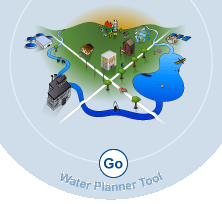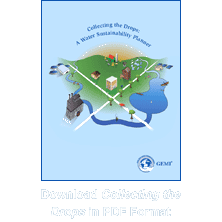The References Tab includes definitions and descriptions that clarify the use of terms in the document.
Predominant sources of fresh water are surface water and ground water, with desalinized and treated wastewater as important sub-categorical sources. Saline water may also be suitable for some direct uses. Terms used to describe water use are:
Beneficial Consumption — The amount of water bound into products or crops; or transpired during crop production. It is considered beneficial since it is inherently part of an economic good for social benefit.
Conservation — Water conservation is a permanent or temporary reduction in water use or losses, achieved through changes in the structural process, institutional, educational or economic means. Permanent conservation is meant to lower overall use. Temporary conservation is part of a suite of tools to deal with the risk of temporary shortages. To be meaningful, it must be analyzed in terms of beneficial end effects. For instance, conserving withdrawals while increasing consumptive use (i.e., closed system vs. evaporative cooling) may be unwise. Beneficial conservation is that where economic, environmental and social benefits exceed the costs.
Consumption — The portion of withdrawn water evaporated, transpired or bound into products or crops. Note that this term is often used by water utilities (and their customers) to describe water delivered and billed to the user (including return flow) — a different concept based on water sales.
Conveyance Loss — The amount of water lost in transit to point of use or from point of release to return point.
Delivery — The amount of water delivered to the point of use.
Grey Water — Water discharged from a process use that may be considered for recycle/reuse.
Gross Water Use — Includes withdrawals, reclaimed wastewater and recirculated water.
Return Flow — The amount of water returned to surface or ground water after release from the point of use. The quality, quantity, temperature and point of return to a watershed or aquifer compared to pre-withdrawal conditions are important elements of sustainability evaluation.
Scarcity — On a global basis, the United Nations and other organizations such as the World Resources Institute (WRI) provide the following thresholds to define scarcity:
• Extremely low <1,000 cubic meters per person per year
• Very low 1,000 to 2,000 cubic meters per person per year
• Low >2,000 to 5,000 cubic meters per person per year
• Medium >5,000 to 10,000 cubic meters per person per year
• High >10,000 to 20,000 cubic meters per person per year
• Very high >20,000 cubic meters per person per year
Withdrawal — The amount of water taken from a surface or ground water source, which may be fresh or saline.





